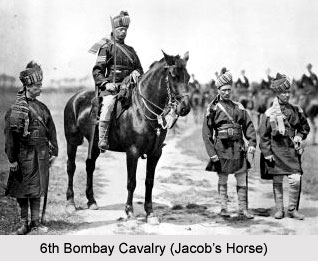 The 6th Bombay Cavalry (Jacob`s Horse) regiment was a British Indian cavalry unit. The regiment was formed in the year 1839 by the British East India Company as a unit of Irregular Horse. It was a division of the Bombay Army, which was the formal military force of the Bombay Presidency. The army of Bombay province was among the three 3 main Presidency Armies in British India, along with the Bengal Army and the Madras Army. The Government of India Act 1858, which was sanctioned after the Sepoy Mutiny in 1857, reassigned the authority of the 3 Presidency Armies to the British Empire in India. Later in 1903, these separate armies were amalgamated to form the United British Indian Army. Hence, the 6th Bombay Cavalry (Jacob`s Horse) also came under the administrative control of the British Crown. The cavalry regiment was also designated as the 36th Jacob`s Horse and the 2nd Regiment of Scinde Horse regiment.
The 6th Bombay Cavalry (Jacob`s Horse) regiment was a British Indian cavalry unit. The regiment was formed in the year 1839 by the British East India Company as a unit of Irregular Horse. It was a division of the Bombay Army, which was the formal military force of the Bombay Presidency. The army of Bombay province was among the three 3 main Presidency Armies in British India, along with the Bengal Army and the Madras Army. The Government of India Act 1858, which was sanctioned after the Sepoy Mutiny in 1857, reassigned the authority of the 3 Presidency Armies to the British Empire in India. Later in 1903, these separate armies were amalgamated to form the United British Indian Army. Hence, the 6th Bombay Cavalry (Jacob`s Horse) also came under the administrative control of the British Crown. The cavalry regiment was also designated as the 36th Jacob`s Horse and the 2nd Regiment of Scinde Horse regiment.
History of 6th Bombay Cavalry (Jacob`s Horse)
The 6th Bombay Cavalry (Jacob`s Horse) unit was established by Lieutenant John Jacob of the Bombay Artillery in the year 1839 as the 2nd Regiment of Scinde Irregular Horse. The purpose of the army unit was to serve as a unit of Irregular Horse and to guard the territory of Scinde, (Sindh province of Pakistan) and its agitated border with Balochistan. During the First Anglo Afghan War, the troops of the 36th Jacob`s Horse later participated in the marches of Southern Afghanistan. It also took part in the annexation and capture of Scinde (Sindh) under Sir Charles Napier.
During the renumbering and re-organization of the regiments of Indian Army in 1922, the 6th Bombay Cavalry regiment was unified with the 35th Scinde Horse in order to raise the 14th Prince of Wales`s Own Scinde Horse.
Designations of 6th Bombay Cavalry (Jacob`s Horse)
The 6th Bombay Cavalry (Jacob`s Horse) regiment underwent several changes in its designation and title during the restructuring and re-grouping of the British Indian Army. They are mentioned below-
* 2nd Regiment of Scinde Irregular Horse in 1839 (reformed in 1846)
* 2nd Regiment of Scinde Horse in 1860
* 9th Regiment of Scinde Silladar Cavalry in 1861
* 2nd Regiment of Scinde Horse in 1861
* 6th Bombay Cavalry (Jacob-Ka-Rissallah) in 1885
* 6th Bombay Cavalry (Jacob`s Horse) in 1888
* Jacob`s Horse in 1903
* 14th Prince of Wales`s Own Scinde Horse (merged with the 35th Scinde Horse) in 1922
Battle Honours of 6th Bombay Cavalry (Jacob`s Horse)
Before the Indian independence and the Partition of India on 15th August 1947, the 6th Bombay Cavalry (Jacob`s Horse) was awarded several Battle Honours for their valuable services in various battles of campaigns. These are listed as follows-
* Cuthchee (Scinde Campaigns)
* Hyderabad
* Meeanee
* Goojerat (Gujarat)
* Mooltan (Multan)
* Punjaub (Punjab, Anglo Sikh Wars)
* Afghanistan 1878- 1880
* Central India
* Cambrai 1917
* Morvai 1917
* France and Flanders 1914- 1918
* Damascus
* Sharon
* Megiddo
* Palestine 1918
* North West Frontier, India 1914-15, 1918



















